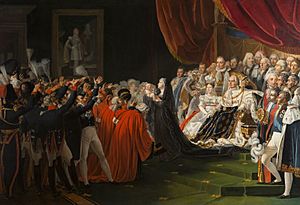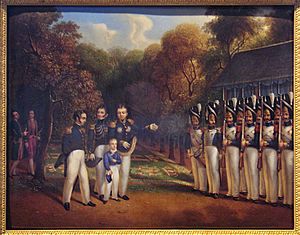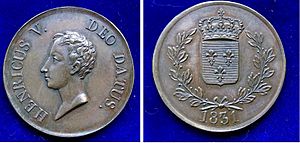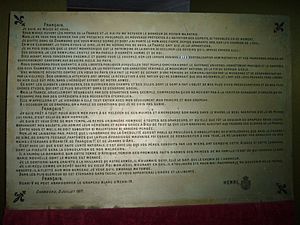Henri, Count of Chambord facts for kids
Quick facts for kids Prince Henri |
|||||
|---|---|---|---|---|---|
| Count of Chambord, Duke of Bordeaux | |||||
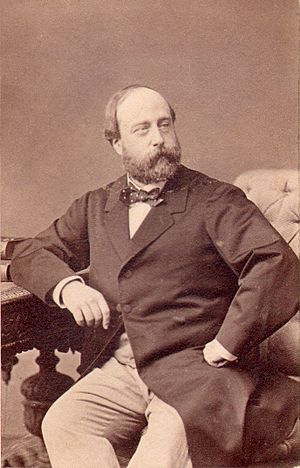 |
|||||
| King of France (disputed) as Henry V |
|||||
| Reign | 2 – 9 August 1830 (Unproclaimed) |
||||
| Predecessor | Charles X Louis XIX (unproclaimed) |
||||
| Successor | Louis Philippe I as King of the French |
||||
| Legitimist pretender to the French throne | |||||
| Pretendence | 3 June 1844 – 24 August 1883 | ||||
| Predecessor | Louis XIX | ||||
| Successor | Legitimist division:
|
||||
| Born | 29 September 1820 Tuileries Palace, Paris, Kingdom of France |
||||
| Died | 24 August 1883 (aged 62) Schloss Frohsdorf, Frohsdorf, Austria-Hungary |
||||
| Burial | Church of the Annunciation of Our Lady | ||||
| Spouse |
Archduchess Maria Theresa of Austria-Este
(m. 1846) |
||||
|
|||||
| House | Bourbon | ||||
| Father | Prince Charles Ferdinand, Duke of Berry | ||||
| Mother | Princess Carolina of Naples and Sicily | ||||
| Religion | Roman Catholicism | ||||
Prince Henri, Count of Chambord and Duke of Bordeaux (born September 29, 1820 – died August 24, 1883) was a French prince. For a short time in August 1830, some people believed he was the King of France, known as Henry V. However, he was never officially crowned. After 1844, he became the main claimant to the French throne for a group called the Legitimists.
Henri was the only son of Charles Ferdinand, Duke of Berry. His father died before he was born. Henri's grandfather was Charles X of France, who was King of France. Henri was the last direct male descendant of Louis XV of France.
Contents
Henri's Early Life
Henri d'Artois was born on September 29, 1820, in the Tuileries Palace in Paris. His father, the Duke of Berry, had been killed seven months before Henri's birth.
When he was born, Henri was given the title duc de Bordeaux. Because he was born after his father's death, and the royal family line was almost ending, one of his middle names was Dieudonné. This means "God-given" in French. Royalists, who supported the king, called him "the miracle child." His birth was a big deal for the royal family.
Becoming a Pretender to the Throne
On August 2, 1830, there was a big uprising in France called the July Revolution. Henri's grandfather, King Charles X, gave up his throne. Just twenty minutes later, Charles's older son, Louis Antoine, also gave up his rights. They both wanted the young Henri to become King Henry V.
However, the new government chose Louis Philippe I to be the King of the French instead. Henri and his family had to leave France and live in exile. Some French royalists still believed Henri was the rightful king. These supporters were called Legitimists. Others supported Louis Philippe.
After his grandfather died in 1836 and his uncle died in 1844, Henri became the most senior claimant to the French throne. He preferred to be called the comte de Chambord (Count of Chambord). This title came from the château de Chambord, a castle given to him by the French government.
In 1846, the Count of Chambord married his cousin, Archduchess Maria Theresa of Austria-Este. They did not have any children.
A Chance for the Throne
In 1870, France lost a war against Prussia. The government at the time, called the Second Empire, fell apart. Royalists then gained control of the National Assembly (the French parliament). This made it seem like the monarchy might return to France.
The Orléanists, who supported another royal family branch, agreed to support Henri's claim. They hoped that since Henri had no children, their own claimant, Prince Philippe, Count of Paris, would become king after Henri died.
So, Henri became the main choice for both Legitimists and Orléanists. But Henri had one big condition: he would only become king if France changed its national flag. He wanted to get rid of the tricolour flag (blue, white, and red) and bring back the old white flag with the fleur de lys (a lily symbol). He refused a compromise where the fleur de lys would be his personal flag, and the tricolour would remain the national flag.
When Pope Pius IX heard about Henri's decision, he famously said, "And all that, all that for a napkin!" This showed how small the flag issue seemed compared to the chance of becoming king.
The End of His Claim
Because Henri refused to accept the tricolour flag, the royalists could not agree. A temporary government, called the French Third Republic, was set up instead. They decided to wait for Henri to die, hoping that the more flexible Count of Paris would then take the throne.
However, by the time Henri died in 1883, most people in France supported the Republic. They saw it as the form of government that caused the fewest disagreements. Some republicans even jokingly called Henri "the French George Washington" because his refusal to compromise helped establish the Republic.
Henri died on August 24, 1883, in Austria, at age 62. He was buried in a church in Slovenia. His death meant the end of the direct male line from Louis XV.
Henri's death caused confusion among his supporters. Some Legitimists believed that the Spanish branch of the Bourbon family should now be the rightful claimants to the French throne. Others followed Henri's earlier suggestion that the Orléans family should lead.
Images for kids
-
The Duchess of Berry and her children by François Gérard, 1822
-
The Duchess of Berry and her son by François Gérard, 1828
See also
 In Spanish: Enrique de Artois para niños
In Spanish: Enrique de Artois para niños


